During this month il-Kamra ta' Fuq will be hosting the second solo exhibition by Karen Caruana, titled The Art of Letting Go, curated by yours truly.
Many know Karen Caruana, while others have only heard of her. A remarkable artist, Karen has been part of the art scene for over 15 years, though she has maintained a low profile for the past five. I remember falling in love with the first work I had seen by her in a collective exhibition over 15 years ago. Needless to say, her style evolved over the years. The biggest change was visible in her debut solo show titled Vernacular, held at the Malta Society of Arts in 2018, curated by Sabrina Calleja Jackson, where the works presented explored surreal compositions where figures appeared to melt and merge, positioned against familiar townscapes and landscapes.

The works featured in The Art of Letting Go were created over the past five years - during which Caruana retreated into her own world, processing life's highs and lows in periods of solitude. These paintings serve as a personal diary, reflecting her journey through introspection and self-preservation. Each piece captures moments of isolation, the cautious desire for new connections, and the revisiting of old, cherished bonds. Caruana's art also delves into insecurities and self-doubt that emerged after enduring phases of emotional survival, with certain works revealing her vulnerability. This body of work speaks to the resilience and complexity of navigating personal growth, capturing her path toward healing with raw, honest expression.

Stylistically, the works in The Art of Letting Go serve as a progression from Caruana's Vernacular series. While traces of her previous style - figures melting and merging - remain, the emphasis here shifts to exploring emotional landscapes and internal struggles. This body of work can be divided into three thematic series, each centred on sadness, pain and the ultimate act of releasing these burdens.
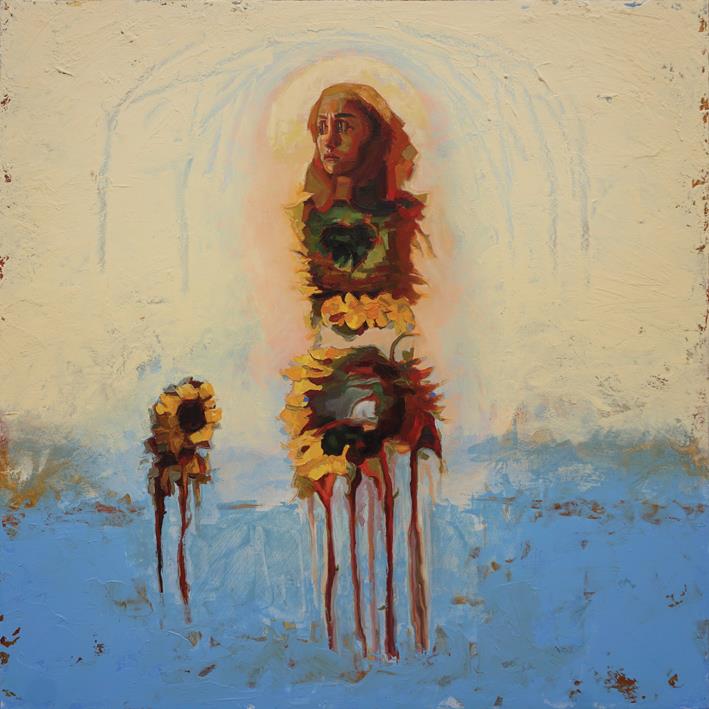
The Sunflowers series features a recurring motif of sunflowers, which act as powerful symbols and personal reminders of someone dear to the artist whom she has since lost. In each piece, solitary figures stand amid fields of these flowers, embodying the solitude of memory and reflection. Buffoon's Intervention presents a surreal, clown-like self-portrait of the artist wading through water surrounded by towering sunflowers. This haunting scene hints at the disorientation of overthinking, where life lessons feel elusive and reality blends with imagination. Another piece, Fool's Gold, features a faceless male figure standing near a cluster of sunflowers, symbolising the blinding allure of self-deception and vulnerability. This character, stripped of identity, represents the perils of clinging to illusions in times of emotional need.
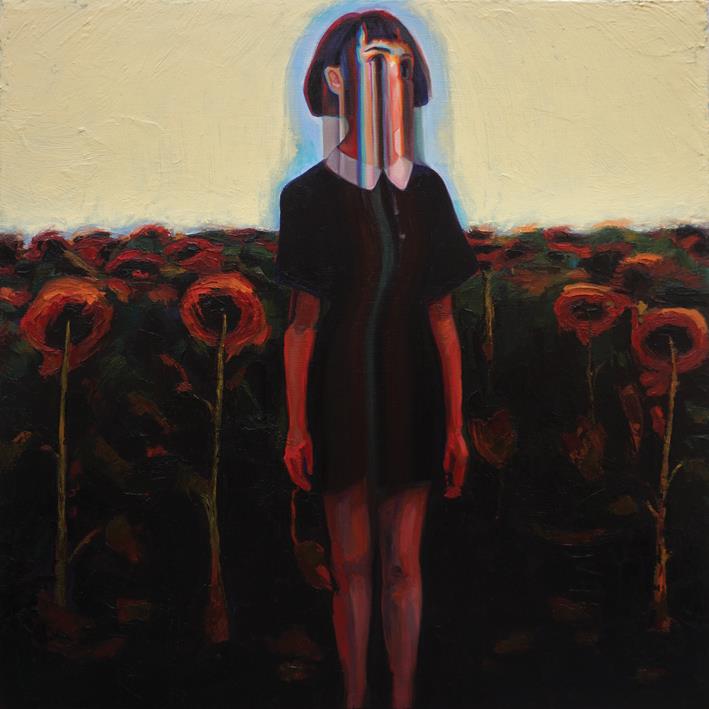
In Vacant Eyes, the sunflower fields transform into a haunting landscape of eyes, symbolising memories that continue to confine the artist. The eyes surround her, each one perhaps a representation of past experiences that still hold her in their grasp. Similarly, the diptych Get a Grip portrays a figure ensnared within a towering forest of sunflowers. At the forest's edge stands another figure, holding a can that could either set the field ablaze or nurture it, hinting at the dual nature of self-doubt and lingering sadness. This ambiguity reflects the artist's insight that sometimes, in moments of despair, we inadvertently nourish our pain, like watering a plant that eventually overwhelms us.
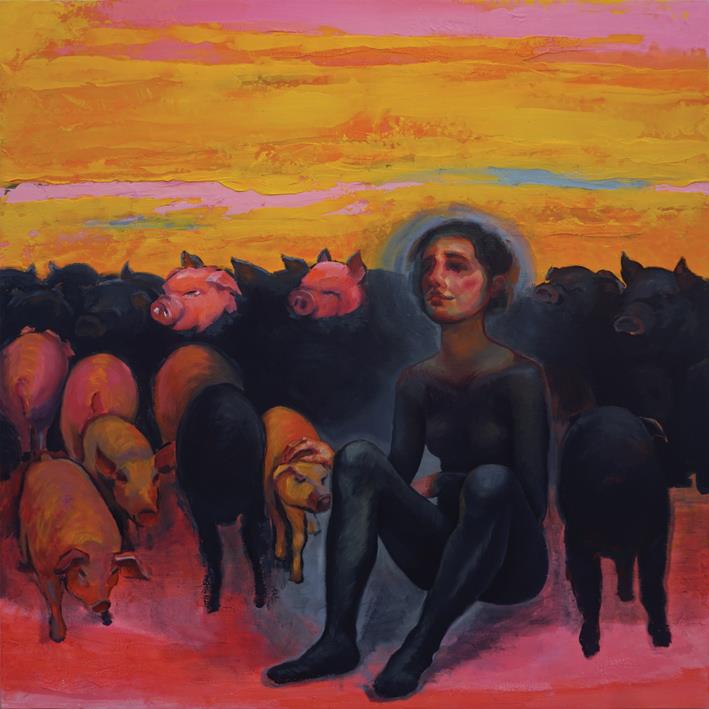
In The Act of Letting Go, the artist portrays herself much larger than the surrounding sunflowers, appearing as a conqueror of past sorrows. Her face, marked with streaks of diluted paint, suggests thoughts and emotions dissolving and flowing away. This piece captures a pivotal moment of release and acceptance, symbolising her journey toward inner peace and the strength found in finally letting go.

In Unfamiliar Equilibrium, we see the beginning and the end of the cycle of dealing with pain and anxiety. The person here is depicted elevated above the field of sunflowers, almost a transfiguration of the unburdened being reaching the heavens, leaving the melting sunflowers rooted to the ground. We decided to place this work at the beginning (and the end) of the exhibition's narrative as it is the state of mind one experiences before the problems and again after dealing with the problems. Another work that delves into a similar subject is the enigmatic piece, The Balancing Act, where we see the figure surrounded by a number of plants, whose roots seem to cover the arms and create some sort of wings. In contrast, we can see a crying eye and a thunderous cloud in the sky, like the internal and the external forces, the sadness and the anxiety.
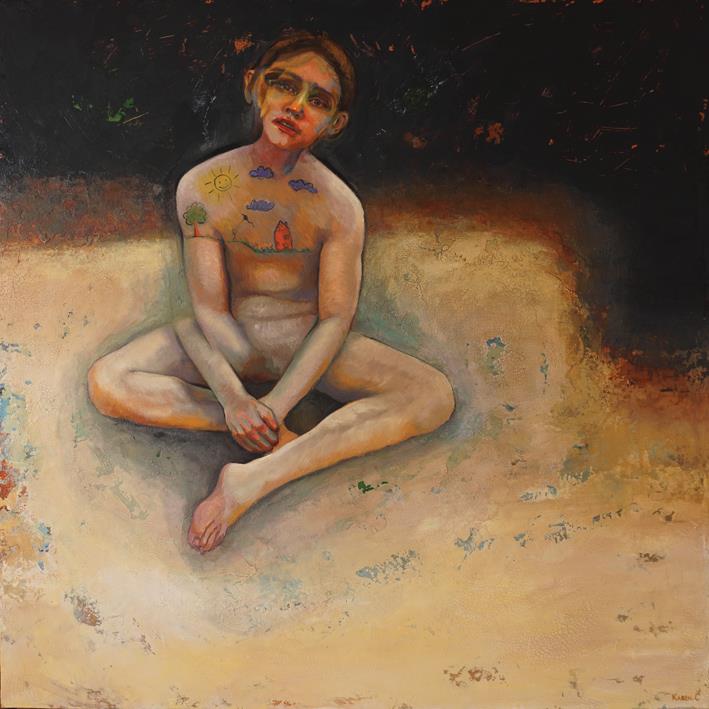
The Balancing Act seamlessly bridges into the next series of works, where the human form takes centre stage. Here, the figure - sometimes depicted only in parts such as the head, arms or hands - becomes a vehicle for powerful, amplified emotions. This progression reflects Caruana's exploration of raw vulnerability, using fragmented forms to highlight the tension and resilience in navigating deeply personal challenges.
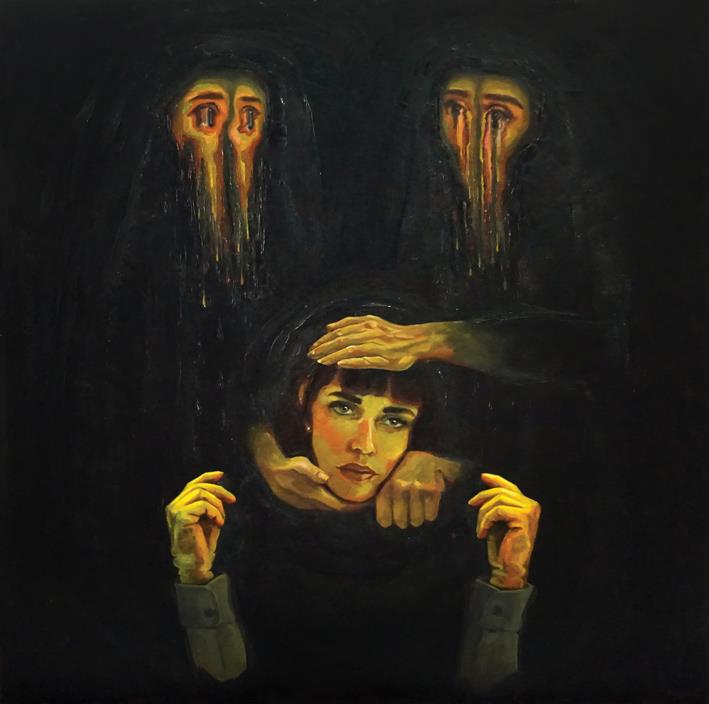
Home is where the Heart is at Peace, chosen as the exhibition's hero image, features a young adult gazing back at the viewer, her expression a blend of distress, anxiety, resignation and calm. Her body is covered in childlike, crayon-like drawings of a sunny house, a garden, and a joyful child flying a kite, evoking both innocence and the desire for simple happiness.
In Hold Tight They Said and Em-brace for the Fall, Caruana revisits her signature technique of merging faces and includes multiple hands and arms forming warm strong embraces. Against a jet-black background, Anticipation of Pain presents a haunting self-portrait of the artist, her head encircled by anonymous hands, while two melting faces resembling cherub heads, frame the composition. At the base of the composition, her raised arms are gloved, recalling the isolation of the pandemic era, the paranoia it induced, and the looming anticipation of loss. This striking image captures a sense of vulnerability and resilience, exploring the complex emotions of fear and the longing for comfort in turbulent times.
The final series of works in the exhibition examines the complex dynamics between individual identity and society. In Safe Space - Maqjel, a shepherd-like figure with a halo sits in a pigsty, surrounded by pigs wallowing in filth, content in their misery - a powerful image that evokes resignation and self-containment amid chaos. Safe Space - Merħla shows a female figure almost lost in a crowd of sheep portrayed over a happy yellow background. Perhaps a struggle or submission to alienation, in following the herd. Or the lack of shame or guilt when one stops struggling to live up to society's standards/expectations or even one's expectations.
This theme of release culminates in the final painting, depicting a "rat lady" standing tall and confidently moving against the flow of other rats. Here, Caruana crafts a metaphor for letting go of the guilt associated with stepping off the treadmill of competition, validation and the relentless chase for money, success and status. Instead, it conveys a sense of inner peace and personal liberation that arises from embracing authenticity over conformity. Through this series, the artist invites viewers to reflect on self-worth, social pressures and the solace found in defining one's path.
These artworks stand as a testament to the beauty that can emerge from darkness, a reminder that light awaits at the end of even the longest tunnel. They capture the delicate balance between grieving and "starting a fire", and the profound peace that comes with releasing burdens and painful memories. Each piece speaks to the resilience of the human spirit, underscoring that through acceptance and catharsis, we can find grace, strength, and ultimately, a sense of renewal.
The exhibition is on until 1 December at il-Kamra ta' Fuq in Mqabba.